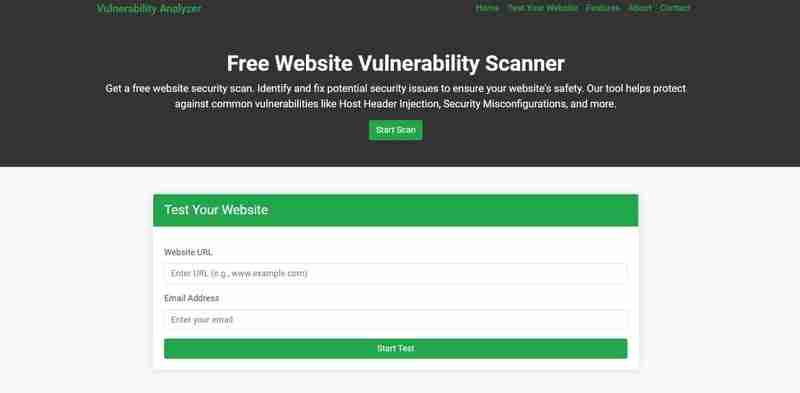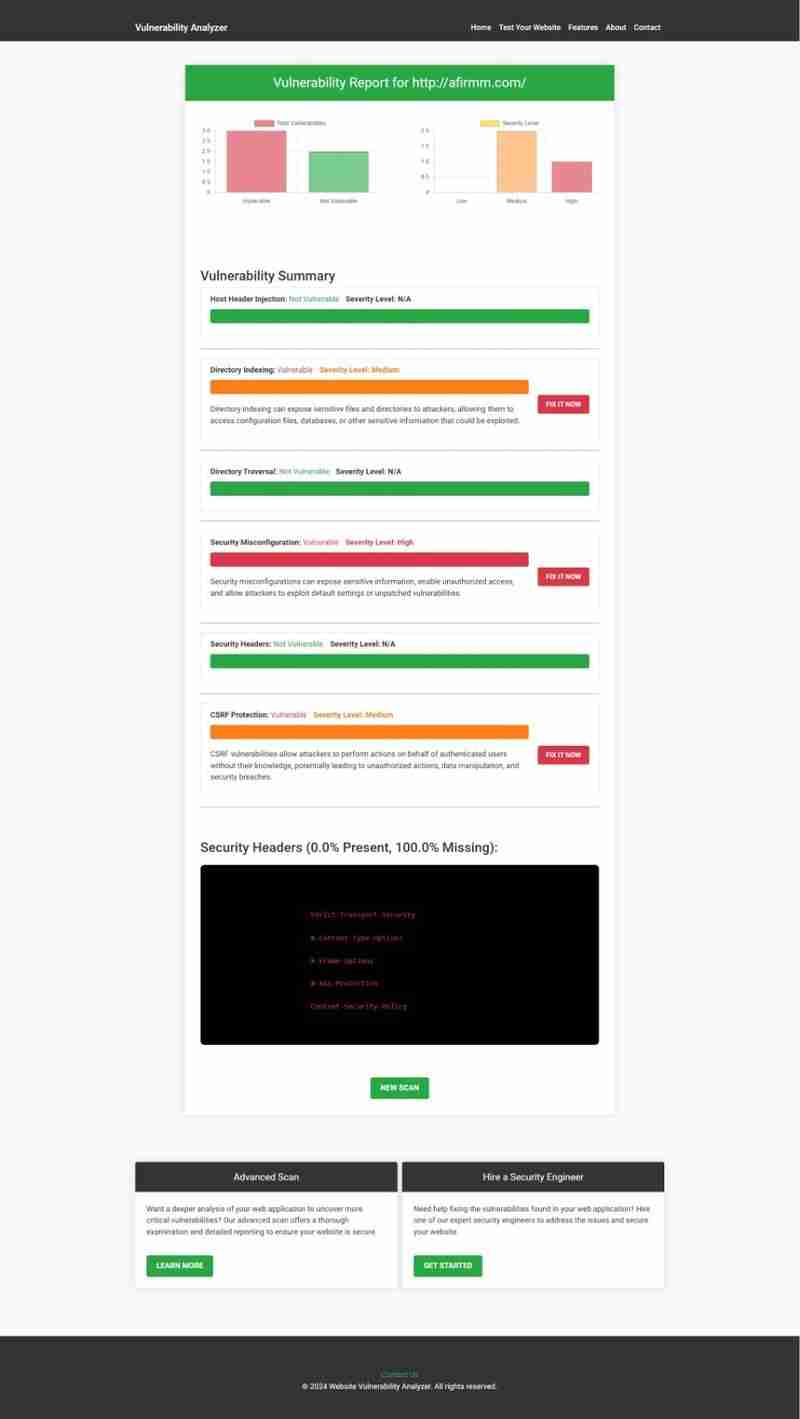 Backend Development
Backend Development
 PHP Tutorial
PHP Tutorial
 Path Manipulation in Laravel: Secure Your App from Vulnerabilities
Path Manipulation in Laravel: Secure Your App from Vulnerabilities
Introduction
Laravel is a popular PHP framework, valued for its clean architecture and developer-friendly environment. However, improper handling of file paths can expose your application to Path Manipulation Vulnerabilities. These vulnerabilities occur when attackers manipulate file paths to access restricted files or directories.

In this blog, we’ll explore what path manipulation is, its risks, and how you can prevent it in Laravel with hands-on coding examples. Additionally, we'll show you how our free Website Security Scanner tool can detect such vulnerabilities in your application.
What is Path Manipulation?
Path manipulation happens when user-controlled input allows access to files outside the intended directory. This can lead to:
- Unauthorized Data Access: Attackers might access sensitive files like configuration or logs.
- File Modification: Attackers could alter critical files.
- Execution of Malicious Scripts: Executing scripts stored in unintended locations.
How Does Path Manipulation Work?
Attackers craft input that exploits the file system’s directory traversal mechanism. For instance:
$file = $_GET['file'];
include("/var/www/html/uploads/" . $file);
If the user sends file=../../etc/passwd, the script could read sensitive server files:
include("/var/www/html/uploads/../../etc/passwd");
Preventing Path Manipulation in Laravel
Laravel provides built-in methods to mitigate such risks. Let’s dive into practical solutions:
1. Validate and Sanitize Inputs
Always validate user inputs to ensure they don’t contain malicious paths.
$request->validate([
'file' => 'required|string|alpha_dash'
]);
2. Use Laravel’s Storage Class
Leverage Laravel’s Storage facade to manage file paths securely:
use Illuminate\Support\Facades\Storage;
$file = $request->input('file');
// Securely fetch the file path
$path = Storage::path('uploads/' . basename($file));
if (Storage::exists($path)) {
return response()->download($path);
}
Coding Example: Secure File Retrieval
Here’s a complete example of securely retrieving files:
$file = $_GET['file'];
include("/var/www/html/uploads/" . $file);
Why This Code is Secure
- basename() prevents directory traversal.
- storage_path() confines file paths to Laravel’s storage directory.
- Ensures the file exists before serving.
How Our Free Tool Detects Path Manipulation
 Screenshot of the free tools webpage where you can access security assessment tools.
Screenshot of the free tools webpage where you can access security assessment tools.
Using our free Website Security Checker, tool you can scan your web application for path manipulation vulnerabilities. The tool generates a detailed vulnerability assessment report, helping you secure your application.
Real-Time Example with Our Tool
Below is a screenshot of a Vulnerability Assessment Report generated by our tool:
 An example of a vulnerability assessment report generated with our free tool provides insights into possible vulnerabilities.
An example of a vulnerability assessment report generated with our free tool provides insights into possible vulnerabilities.
Conclusion
Path manipulation vulnerabilities can compromise your Laravel applications. By validating inputs, using secure methods like Storage, and conducting regular vulnerability assessments with tools like ours to test website security free, you can significantly reduce risks.
Take proactive steps to secure your application today, and don’t forget to test your application regularly with our tool for enhanced protection.
Have you scanned your Laravel application for vulnerabilities? Check it now with our free Website Security Scanner and stay secure!
The above is the detailed content of Path Manipulation in Laravel: Secure Your App from Vulnerabilities. For more information, please follow other related articles on the PHP Chinese website!

Hot AI Tools

Undress AI Tool
Undress images for free

Undresser.AI Undress
AI-powered app for creating realistic nude photos

AI Clothes Remover
Online AI tool for removing clothes from photos.

Clothoff.io
AI clothes remover

Video Face Swap
Swap faces in any video effortlessly with our completely free AI face swap tool!

Hot Article

Hot Tools

Notepad++7.3.1
Easy-to-use and free code editor

SublimeText3 Chinese version
Chinese version, very easy to use

Zend Studio 13.0.1
Powerful PHP integrated development environment

Dreamweaver CS6
Visual web development tools

SublimeText3 Mac version
God-level code editing software (SublimeText3)

Hot Topics
 How do I implement authentication and authorization in PHP?
Jun 20, 2025 am 01:03 AM
How do I implement authentication and authorization in PHP?
Jun 20, 2025 am 01:03 AM
TosecurelyhandleauthenticationandauthorizationinPHP,followthesesteps:1.Alwayshashpasswordswithpassword_hash()andverifyusingpassword_verify(),usepreparedstatementstopreventSQLinjection,andstoreuserdatain$_SESSIONafterlogin.2.Implementrole-basedaccessc
 How can you handle file uploads securely in PHP?
Jun 19, 2025 am 01:05 AM
How can you handle file uploads securely in PHP?
Jun 19, 2025 am 01:05 AM
To safely handle file uploads in PHP, the core is to verify file types, rename files, and restrict permissions. 1. Use finfo_file() to check the real MIME type, and only specific types such as image/jpeg are allowed; 2. Use uniqid() to generate random file names and store them in non-Web root directory; 3. Limit file size through php.ini and HTML forms, and set directory permissions to 0755; 4. Use ClamAV to scan malware to enhance security. These steps effectively prevent security vulnerabilities and ensure that the file upload process is safe and reliable.
 What are the differences between == (loose comparison) and === (strict comparison) in PHP?
Jun 19, 2025 am 01:07 AM
What are the differences between == (loose comparison) and === (strict comparison) in PHP?
Jun 19, 2025 am 01:07 AM
In PHP, the main difference between == and == is the strictness of type checking. ==Type conversion will be performed before comparison, for example, 5=="5" returns true, and ===Request that the value and type are the same before true will be returned, for example, 5==="5" returns false. In usage scenarios, === is more secure and should be used first, and == is only used when type conversion is required.
 How do I perform arithmetic operations in PHP ( , -, *, /, %)?
Jun 19, 2025 pm 05:13 PM
How do I perform arithmetic operations in PHP ( , -, *, /, %)?
Jun 19, 2025 pm 05:13 PM
The methods of using basic mathematical operations in PHP are as follows: 1. Addition signs support integers and floating-point numbers, and can also be used for variables. String numbers will be automatically converted but not recommended to dependencies; 2. Subtraction signs use - signs, variables are the same, and type conversion is also applicable; 3. Multiplication signs use * signs, which are suitable for numbers and similar strings; 4. Division uses / signs, which need to avoid dividing by zero, and note that the result may be floating-point numbers; 5. Taking the modulus signs can be used to judge odd and even numbers, and when processing negative numbers, the remainder signs are consistent with the dividend. The key to using these operators correctly is to ensure that the data types are clear and the boundary situation is handled well.
 How can you interact with NoSQL databases (e.g., MongoDB, Redis) from PHP?
Jun 19, 2025 am 01:07 AM
How can you interact with NoSQL databases (e.g., MongoDB, Redis) from PHP?
Jun 19, 2025 am 01:07 AM
Yes, PHP can interact with NoSQL databases like MongoDB and Redis through specific extensions or libraries. First, use the MongoDBPHP driver (installed through PECL or Composer) to create client instances and operate databases and collections, supporting insertion, query, aggregation and other operations; second, use the Predis library or phpredis extension to connect to Redis, perform key-value settings and acquisitions, and recommend phpredis for high-performance scenarios, while Predis is convenient for rapid deployment; both are suitable for production environments and are well-documented.
 How do I stay up-to-date with the latest PHP developments and best practices?
Jun 23, 2025 am 12:56 AM
How do I stay up-to-date with the latest PHP developments and best practices?
Jun 23, 2025 am 12:56 AM
TostaycurrentwithPHPdevelopmentsandbestpractices,followkeynewssourceslikePHP.netandPHPWeekly,engagewithcommunitiesonforumsandconferences,keeptoolingupdatedandgraduallyadoptnewfeatures,andreadorcontributetoopensourceprojects.First,followreliablesource
 What is PHP, and why is it used for web development?
Jun 23, 2025 am 12:55 AM
What is PHP, and why is it used for web development?
Jun 23, 2025 am 12:55 AM
PHPbecamepopularforwebdevelopmentduetoitseaseoflearning,seamlessintegrationwithHTML,widespreadhostingsupport,andalargeecosystemincludingframeworkslikeLaravelandCMSplatformslikeWordPress.Itexcelsinhandlingformsubmissions,managingusersessions,interacti
 How to set PHP time zone?
Jun 25, 2025 am 01:00 AM
How to set PHP time zone?
Jun 25, 2025 am 01:00 AM
TosettherighttimezoneinPHP,usedate_default_timezone_set()functionatthestartofyourscriptwithavalididentifiersuchas'America/New_York'.1.Usedate_default_timezone_set()beforeanydate/timefunctions.2.Alternatively,configurethephp.inifilebysettingdate.timez





